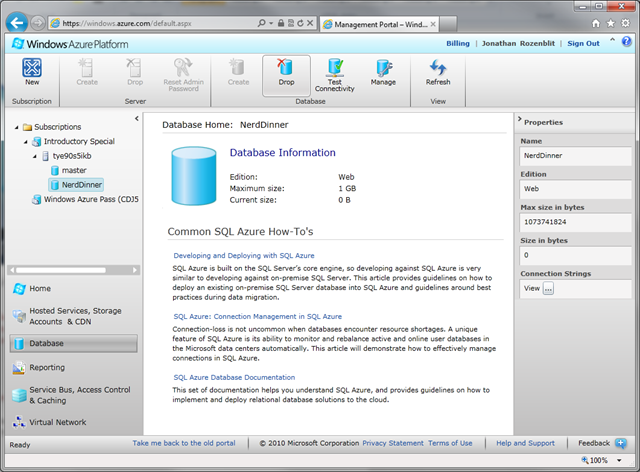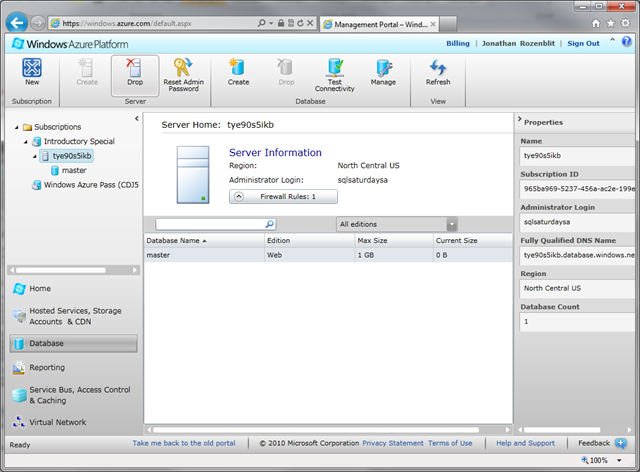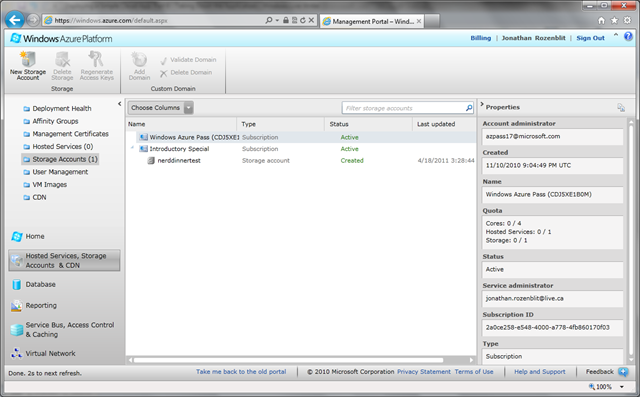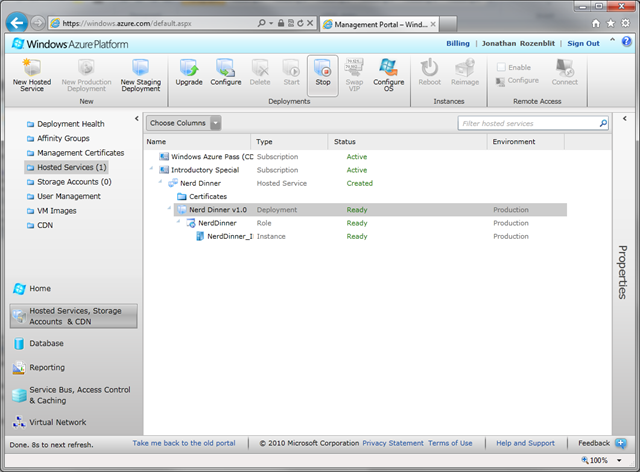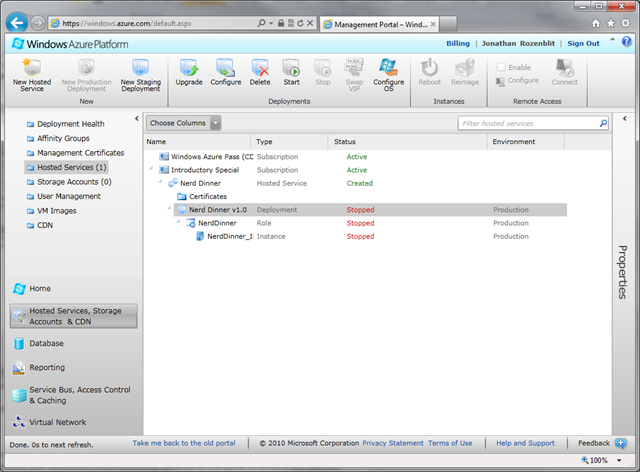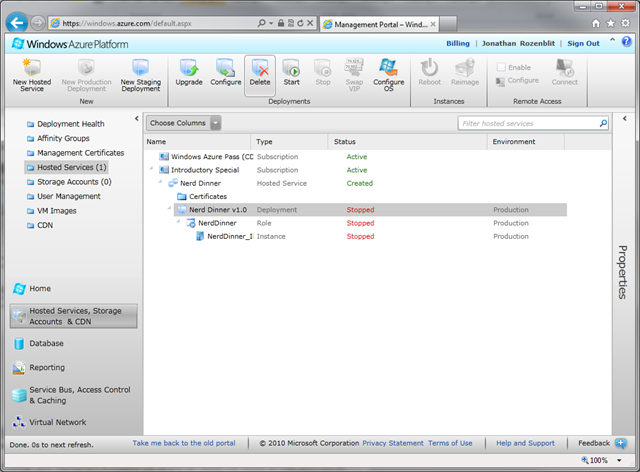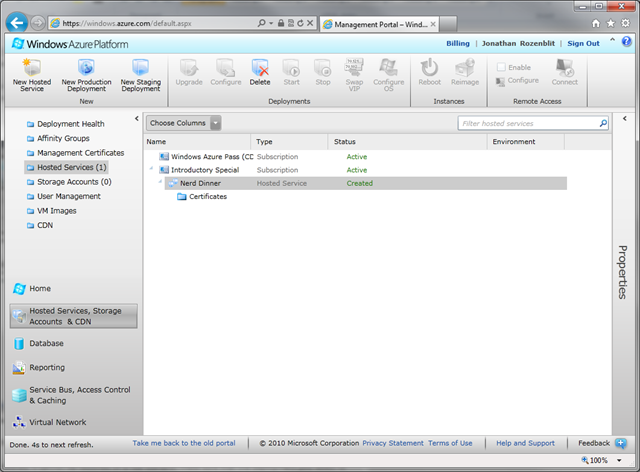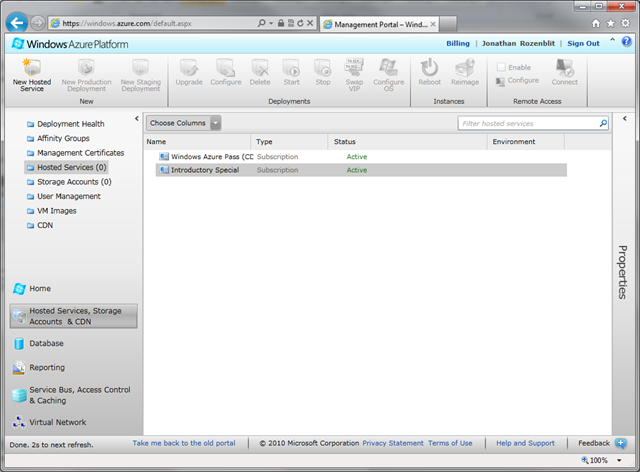Deploying a Simple Cloud App: Part 6 - Taking Down the Application
If you’ve started reading from this post, you’ll need to go through the previous parts of this series before starting this one:
Introduction
Part 1: Provisioning and Configuring SQL Azure
Part 2: Provisioning a Storage Account
Part 3: Configuring the Service Package
Part 4: Configuring the Hosted Service, Deploying the Package, and Testing
Part 5: Promoting from Staging to Production
![Deploying-a-Simple-Application_thumb[3] Deploying-a-Simple-Application_thumb[3]](https://msdntnarchive.blob.core.windows.net/media/TNBlogsFS/prod.evol.blogs.technet.com/CommunityServer.Blogs.Components.WeblogFiles/00/00/00/48/12/metablogapi/5327.Deploying-a-Simple-Application_thumb3_thumb_67E07815.png) Since this deployment is for learning purposes only, we need to make sure that we take down the deployment so as to make sure that your credit card won’t be billed.
Since this deployment is for learning purposes only, we need to make sure that we take down the deployment so as to make sure that your credit card won’t be billed.
Dropping the SQL Azure Database
From the Windows Azure Management Portal, click on Database in the left hand navigation.
In the left hand top navigation, expand the subscription under which you created the SQL Azure database server and database.
Expand the SQL Azure database server and highlight the NerdDinner database.
Click Drop from the ribbon.
You’ll be asked if you want to drop the database. Click Drop.
The database has now been dropped.
IMPORTANT: Once a database is dropped, it can’t be restored. In a real scenario, make sure that the database you select to drop is, in fact, the database you want to drop.
Dropping the SQL Azure Server
Select the server node in the left hand top navigation.
Click Drop from the top toolbar.
You’ll be asked if you want to drop the server. Click Drop.
The database server has now been dropped.
IMPORTANT: Once a database server is dropped, it can’t be restored. In a real scenario, make sure that the server you select to drop is, in fact, the server you want to drop.
Deleting the Storage Account
Click on Hosted Services, Storage Accounts & CDN from the left hand bottom navigation.
Click on Storage Accounts (X) (where X is the number of storage account that you have provisioned) from the left hand top navigation.
From the right hand list, expand the subscription under which you provisioned the storage account.
Click on the account you provisioned earlier.
Click Delete Storage from the top ribbon.
You’ll be asked if you’re sure you want to delete the storage service. Click Yes.
The storage account has now been deleted.
IMPORTANT: Once a storage account is deleted, the account and everything stored in it is deleted and it can’t be restored. In a real scenario, make sure that the account you select to delete is, in fact, the account you wanted to delete.
Deleting the Hosted Service
Click on Hosted Services, Storage Accounts & CDN from the left hand bottom navigation.
Expand the subscription under which you created the hosted service.
Expand the previously created hosted service.
Click on the row that specifies Deployment as the type.
Click Stop in the ribbon.
After a few moments, the list will refresh indicating that the deployment has been stopped.
NOTE: From a billing perspective, even though your deployment is stopped (i.e. no one can access the hosted service), you’ll still be billed for the compute hours. This is because your deployment is still consuming resources on the server to which it was deployed.
With the deployment still highlighted, click Delete from the ribbon.
You’ll be asked if you want to delete the deployment. Click Yes.
IMPORTANT: Once a deployment is deleted, it can’t be restored. In a real scenario, make sure that the deployment you select to delete is, in fact, the deployment you want to delete.
After a few moments, you will see that the deployment has been deleted.
Click on the row that specifies Hosted Service as the type.
Click Delete from the toolbar.
You’ll be asked if you want to delete the hosted service. Click Yes. After a few moments, you will see that the hosted service has been deleted.
With that, you’ve now removed all of the resources that you allocated during the setup the environment.
Congratulations!
You have successfully set up staging and production environments, deployed an application to the Cloud, and then decommissioned those environments when they were no longer required. Let’s take a step back for a moment and reflect on what we’ve done here and the ease with which we did it. We’ve proven why Cloud computing works and how IT Pros, such as yourself, now have an infinite platform on which to deploy solutions that deliver on business opportunities without the constraints of physical infrastructure and geographic location.
Comments and Feedback
Take a moment to share what you thought of the walkthrough, what you’ve learned, and what next steps you’ll take on your journey to the Cloud in this LinkedIn group discussion. I’ll be reading through your responses and taking your feedback as input for next walkthrough and series of events that we’ll do together. We’ll go deeper into Windows Azure concepts and explore further.
